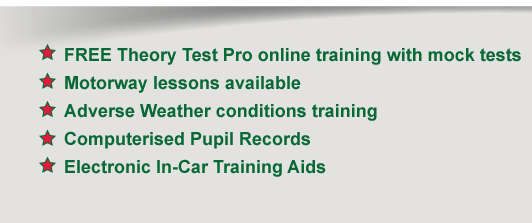


Show Me Tell Me Qustions
At the start of the practical driving test, the driving examiner will ask you two 'show me, tell me questions' based on basic vehicle maintenance.
One will be a 'tell me' how to do something question, explaining how to check the tyre pressure for example.
The other question will be a 'show me' question. That's where you will have to physically show the examiner how you would do something, for example testing the horn.
1. Open the bonnet, identify where you would check the engine oil level and tell me how you would check that the engine has sufficient oil.
Identify dipstick / oil level indicator, With the engine turned off, pull out the dipstick and wipe it clean. Replace the dipstick then remove and check oil level against the minimum and maximum markers.
2. Open the bonnet, identify where you would check the engine coolant level and tell me how you would check that the engine has the correct level.
Identify minimum and maximum level markings on header tank (Large whiteish bottle with a silver cap on the top left), and describe how to top up to correct level.
3. Open the bonnet, identify where the brake fluid reservoir is and tell me how you would check that you have a safe level of hydraulic brake fluid.
Identify brake fluid reservoir(Whiteish bottle with a black cap, hidden on the top right ), check level against minimum and maximum markings.
4. Identify where the windscreen washer reservoir is and tell me how you would check the windscreen washer level.
Identify windscreen washer reservoir (Whiteish bottle with a blue cap, front left) and explain how to check level.
5. Tell me how you would check that the headlights & tail lights are working.
Operate headlights switch (Rotary switch on the end of the indicator stalk) turn it upwards 2 positions and walk around the vehicle.
6. Show me / explain how you would check that the power assisted steering is working before starting a journey.
If the steering becomes heavy the system may not be working properly. Before starting a journey two simple checks can be made. Gentle pressure on the steering wheel, maintained while the engine is started, should result in a slight but noticeable movement as the system begins to operate. Alternatively, turning the steering wheel just after moving off will give an immediate indication that the power assistance is functioning.
7. Show me how you would check the parking brake for excessive wear.
Apply footbrake firmly. Demonstrate by applying parking brake that when it is fully applied it secures itself, and is not at the end of the working travel.
8. Show me how you would check that the horn is working (off road only).
Check is carried out by using the horn control (turn on ignition if necessary).
9. Show me how you would check that the direction indicators are working.
Apply the hazard warning switch ( located on the center consol with the climate controls) and walk around the vehicle, checking all indicators.
10. Tell me how you would check the tyres to ensure that they have sufficient tread depth and that their general condition is safe to use on the road.
Sides of tyres should have no cuts or bulges. There should be a minimum of 1.6mm of tread depth across the central ¾ of the breadth of the tyre and around the entire outer circumference.
11. Show me how you would check that the brake lights are working on this car.
Operate brake pedal and make use of reflections in windows, garage doors, etc. Alternatively, ask someone to help check the lights for you as you press the pedal.
12. Tell me how you would check the brakes are working before starting a journey.
Brakes should not feel spongy or slack. Brakes should be tested as you set off. Vehicle should not pull to one side.
13. Tell me where you would find the information for the recommended tyre pressures for this car and how tyre pressures should be checked.
Recommended pressures can be found in the manufacturer's guide. Use a reliable pressure gauge. Check and adjust pressures when tyres are cold. Don't forget to check the spare tyre. Remember to refit valve caps.
14. Tell me how you would know if there was a problem with your anti-lock braking system.
A warning light will illuminate on the dashboard if there is a fault with the anti lock braking system.
15. Show me how you switch your headlight from dipped to main beam and explain how you would know the main beam is on whilst inside the car.
Operate headlight switch then main beam switch (Rotary switch on the end of the indicator stalk)turn it upwards 2 positions then push the entire stalk away from you. Check main beam warning light is on.
16. Show me how you would switch on the rear fog light(s) and explain when you would use it/them.
Operate fog light switch (turn on dipped headlights then turn the toggle switch further down the indicator stalk). Check warning light is on. This light should only be used when visability is below 100 meters.
17. Show me how you would clean the windscreen using the windscreen washer and wipers.
Operate control to wash and wipe windscreen (Stalk on the opposite side to the indicator)Pull the wiper stalk towards you.
18. Tell me me how you make sure your head restraint is correctly adjusted so it provides the best protection in the event of a crash.
The head restraint should be adjusted so the rigid part of the head restraint is at least as high as the eye or top of the ears, and as close to the back of head as possible.
19. Show me how you would set the demister controls to clear all the windows effectively. This should include the front and rear screens.
Set all relevant controls including: fan, temperature, air direction/source and heated screen to clear windscreen and windows(Push the "Front" and "Rear" located on the center consol) .







